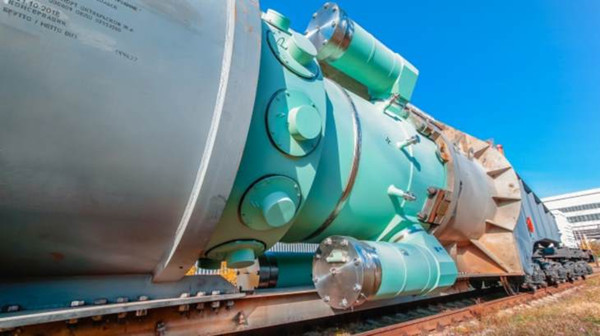Russia completes second reactor for Ural icebreaker
Zio-Podolsk, a subsidiary of Russian state nuclear corporation Rosatom, has dispatched the second reactor for the Ural nuclear-powered icebreaker under construction at the Baltic Shipyard in Saint Petersburg.

The second RITM-200 reactor for the Ural icebreaker (Image: Rosatom)
The first of the two reactors for the vessel was shipped on 24 September and the second on 16 October, and Zio-Podolsk said it has thus completed this stage in its "significant contribution to the development and updating of the Russian nuclear icebreaker fleet".
Ural is one of three vessels of Project 22220 - featuring RITM-200 reactors - that will be able to break through ice 3 meters thick as they escort vessels across the Arctic Ocean. The others are Arktika and Sibir. Zio-Podolsk produced the reactors for Arktika in 2016 and for Sibir last year.
"The development and mastering of the production of these reactor installations is extremely important not only for the development of the icebreaker fleet, but also for the nuclear power industry in general, the development of the Arctic shelf, as well as the expansion of the country's export potential in the advanced technology sector," Andrey Nikipelov, general director of Atomenergomash, said in a Rosatom statement. Zio-Podolsk is a unit of Atomenergomash, Rosatom’s power engineering division.
Arktika, Sibir and Ural are third-generation 'universal' LK-60 icebreakers that are being built as dual-draught (8.55 or 10.5m) wide-beam (34m) ships of 25,450 dwt or 33,540 dwt with ballast, able to handle 3 meters of ice. They each have two RITM-200 reactors of 175 MWt each, delivering 60 MW at the propellers via twin turbine-generators and three motors.
A more powerful LC-110 icebreaker of 110 MW net and 55,600 dwt is planned to be capable of breaking through ice up to 4.5 m thick. The first of this design of vessel will be Leader.
Nikipelov added: "We consider RITM-200 and its modifications as the basis for creating nuclear power plants of low sea and terrestrial capacity, which will allow us to quickly and efficiently solve the issues of power supply to remote territories. Also, the timely completion of the contract on RITM-200 allows us to count on participation in the construction of the Leader nuclear-powered icebreakers, which will have to ensure the year-round operation of the Northern Sea Route. At present, a draft design of the RITM-400 reactor facility has been created for this type of vessel and a technical project is being developed.”
- China Institute of Atomic Energy
- Nuclear Power Institute of China
- Southwestern Institute of Physics
- China Nuclear Power Operation Technology Corporation, Ltd.
- China Nuclear Power Engineering Co., Ltd.
- China Institute for Radiation Protection
- Beijing Research Institute of Uranium Geology (BRIUG)
- China Institute of Nuclear Industry Strategy (CINIS)
- China Nuclear Mining Science and Technology Corporation


